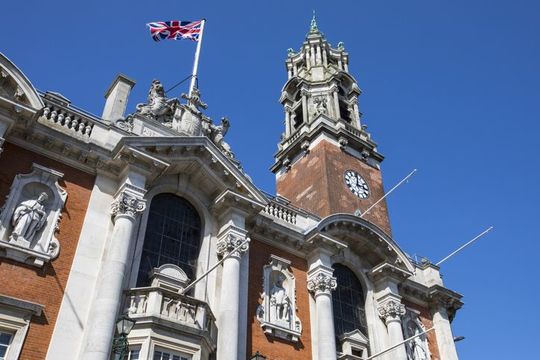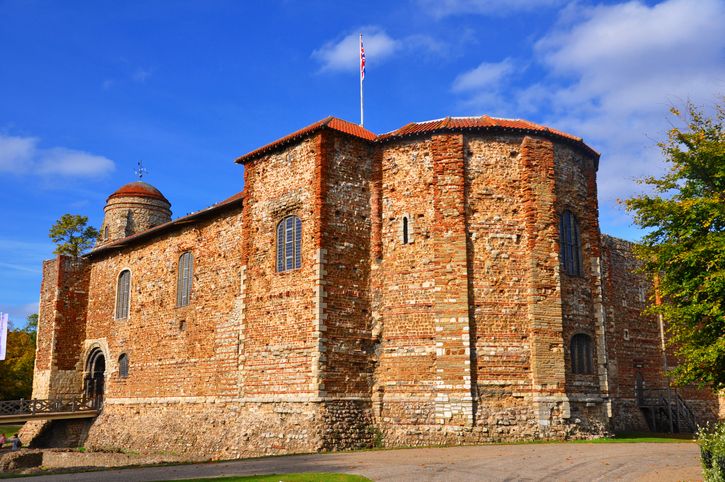
ColchesterGetty images
You can't beat Colchester in Essex for an English town steeped in history and heritage.
It's where the Romans built their first town on British soil in AD 43. Today, ruined buildings from those early days of Roman rule draw tourists from around the world.
The Ancient Romans called the town 'Camulodunum' (it's Iron Age name) or 'Colonia Claudia Victricensis' and it started out as a Roman Legionary base and expanded to become the centre of Roman rule in England. A large classical temple stood in the centre of the town, and there was a cultural quarter with two theatres, several temples, a chariot circus, ornamental mosaics and burial grounds, all enclosed within a large town wall. It's thought that around 30,000 people lived there in its heyday.
Today, Colchester Castle stands on the foundations of a former Roman temple, surrounded by parkland and gardens - it's known as Colchester Castle Park. The area is divided into the Upper Park and Lower Park by a Roman Wall that formed part of the original town wall of Roman 'Colonia Claudia Victricensis'.
Colchester Castle itself was built by the Normans, for William the Conqueror, following his victory at the Battle of Hastings in 1066. The castle keep is the largest in Europe and guided tours take you to see parts of the castle that aren't usually open to visitors.
The Castle came under fire for three months in 1216, and saw the French custodian flee when King John's men seized the fortress. However, the following year, the castle was returned to the French and the barons who supported them, as part of a truce agreement between the two nations.
By the seventeenth century the Castle was in a state of disrepair and parts of it were demolished. In 1645, Matthew Hopkins Witchfinder General, turned what remained of the castle into a prison and place of interrogation for women accused of witchcraft.
Three years later, the Second English Civil War was in full swing and the Royalist leaders Sir Charles Lucas and Sir George Lisle were executed in the Castle grounds. There's a legend saying that grass won't grow on the spot where they died.

Colchester
In the early 18th century the Castle ruins were used as a grain store. Then in 1740, restoration work began and a landscaped park was created. Over the next 20 years, a library and cupola was added to the building. Part of the castle continued to serve as a gaol, and John Smith, the gaoler and his family lived in a restored part of the building. His daughter, Mary Ann Smith, grew up in the castle in the 1770s, and became the librarian until she passed away in 1852. In 1860 Colchester Museum was moved into the Castle. It housed an impressive collection of Roman artifacts. The Castle and parkland were eventually purchased by Colchester Borough Council in the early 1920s. Today, modern exhibitions and interactive displays help bring the history of Colchester alive.
The Museum experience begins by looking at Colchester during the Iron Age. It was a time when people lived in roundhouses, made pottery and learned the art of metalworking. Early trade included the importing and exporting of goods and crafts with other European countries.
The first Roman Invasion of Colchester was in the year 54 BC, but they left after a couple of months, returning with a bigger army in AD 43, when 'Colonia Claudia Victricensis' became the first Roman city ever created on British soil.
Today the Museum displays Roman artifacts, mosaics, ornaments, pots, glass, jewelry and crafts, rescued from archaeological digs in the area. One display explores the conflict between the invading Roman Army and the Queen of Suffolk and Norfolk, Queen Boudicca. She invaded Roman Colchester with the Iceni Army in AD 60, after the Romans stole riches from her kingdom, mistreated her people, and humiliated her. The Iceni Tribe Revolt caused massive damage to the Romans at that time - many Roman buildings went up in flames including one of their temples. The siege sent a clear message to the Romans that they could not treat neighboring kingdoms badly and expect them to lie down and take it.
In 410 AD the Romans left Britain and the Anglo-Saxons moved in. The Anglo-Saxons weren’t interested in maintaining Roman buildings. They let them fall to ruin. They had simple lives and weren’t interested in many of the conveniences that the Romans had introduced, such as baths, latrines (toilets), and stone houses. They lived in simple huts and led simple lives. Anglo-Saxon artifacts from this period are on display.
The Roman temple, which had been rebuilt after the fire, fell to ruin and eventually Colchester Castle was built on the foundations. The guided tour of Colchester Castle takes you down to the basement, where the original rooms from the Roman Villa remain - although they have been separated by walls of concrete, to strengthen the castle’s foundations. The guided tour then takes you up to the roof, where you see across the town, and visit the room in the roof, sometimes used for weddings.
Back in the galleries, you'll learn about medieval life at the castle, crafts, trades and industry, and the abundant medieval artifacts found in the grounds. A section on the Civil War explains how the Royalists surrendered to the Parliamentarians, after a long and bloody battle. Local people were reduced to eating their pets, rats, and even candles made from animal fat, because food insecurity, caused by the ongoing fighting, left them starving.
The Castle is compact but there’s a lot to see. Head into the café across the road to see more Roman ruins under the floor. These are the foundations of the gateway into the original Roman temple compound. Don't forget to explore the beautiful Castle Gardens while you're there, with colorful flower beds, topiary, Roman walls, and a river. Look out for the friendly squirrels who approach people, looking for food.
Beside Colchester Castle stands Hollytrees Museum, a Georgian Townhouse where the collections on display include a fabulous Childhood Gallery, packed with historic toys and games, and a look at Colchester’s heritage as a clock-making town. A variety of locally made clocks are on display. Dolls houses show how the old building might have been furnished in its heyday, and you can explore domestic life in times past, with old kitchen and laundry equipment. The history of the local economy is explored and exhibitions tell you about the people who lived in this house and owned the Castle next door.
Just across the road from the Castle Gardens is Colchester Natural History Museum, located inside an old church. The exhibitions inside explore local wildlife and threatened species, as well as the impact of climate change and its impact on wildlife around the world. There’s a display of fossils found locally, and exhibits looking at marine life, sea birds and migratory birds on the Essex coast. It's a small museum but it has some interesting displays, including the history of Essex going back to the Ice Age - and a woolly mammoth’s tooth.
A short walk away is the First Site Art Gallery, a very modern building, displaying changing exhibitions of modern art and sculpture. During our visit, there was a darkened room with a psychedelic display of lights and patterns projected onto a big screen, accompanied by a commentary exploring what people see in the patterns. There was also a visual illusion showing a ‘spinning’ shape, except that it wasn’t spinning – it was just a clever trick of the light. Other displays included patchwork fabrics draped over poles, and collections of objects old and new. Some displays are a bit odd. Some make you think. More conventional artwork includes life-like portraits and abstract paintings.
Next door a community gallery has changing exhibitions of fine art, oil paintings on canvas and textile art. Previous themes include climate change and plastic pollution, highlighting the dire situation facing our natural world.
Colchester has a vibrant town center, with lots of different shops and places to dine. It's a place where modern architecture stands alongside historic buildings, with diverse attractions catering for young and old alike. It's a place of modern art and open minds.
New sculptures were introduced to the main shopping street in 2017, designed by Sean Henry, whose work is exhibited across Europe, in London and New York. The bronze sculptures are the 4'6" Man with Cup, and the 7' Walking Woman. When they were unveiled the artist said, "These two sculptures, although based on real people, are deliberately anonymous and set out to celebrate our united humanity. They will share the public space of the High Street with us and so offer the viewer something to identify with, to ask questions about and hopefully relate to."
A short drive outside the town center, animal lovers will enjoy a visit to Colchester Zoo, where you can see over 220 species of animals, including bears, monkeys, wolves and big cats. Elephants, reptiles, deer, giraffes, penguins and meerkats will keep the family entertained for hours.
Eight miles west of Colchester in a small town called Coggeshall, is a National Trust house called Paycockes. In the 16th century it was owned by a wealthy wool merchant, Thomas Paycocke, who made fine cloth from wool and sold it across the land. He was trying to make an impression when he commissioned the construction of Paycockes, keen to impress the new King, Henry VIII. The house was situated on the edge of a Roman road, so all passing trade would see its grandeur.
The oldest part of the building dates to around 1420, when it was part of an open medieval hall. Thomas Paycocke commissioned the construction of the newer parts of the house between 1509 and 1510.
Paycockes was the second house ever given to the National Trust, a charity that owns many historic properties in England today. It was transferred to the Trust's ownership in 1924. Dark oak panels line the walls of this typically Tudor building. The heavy finish makes the rooms dark. In the Hall, used for entertaining, is a heavy oak table with a counting board. In another room is a small desk, and up the stairs is a grand dining room and a bedroom, with a four-poster bed. Today, some of the former living rooms are taken up by the National Trust shop and cafe, so the living space feels smaller than it would have been when Thomas Paycocke and his family were living there. The gardens are pretty and the cafe serves nice cake.
It's a short walk to Grange Barn, another National Trust property, once owned by the local Abbey. There's an exhibition about its history inside. It seems the monks from the Abbey weren't very holy - they were fined for several local murders, and the vicar was fined for stealing fish from the Abbey ponds. You can see carts and an old threshing machine in the barn, as well as an exhibition about Coggeshall's craftsmen in times past.
Colchester and its surrounding towns are steeped in history and heritage.





Comments